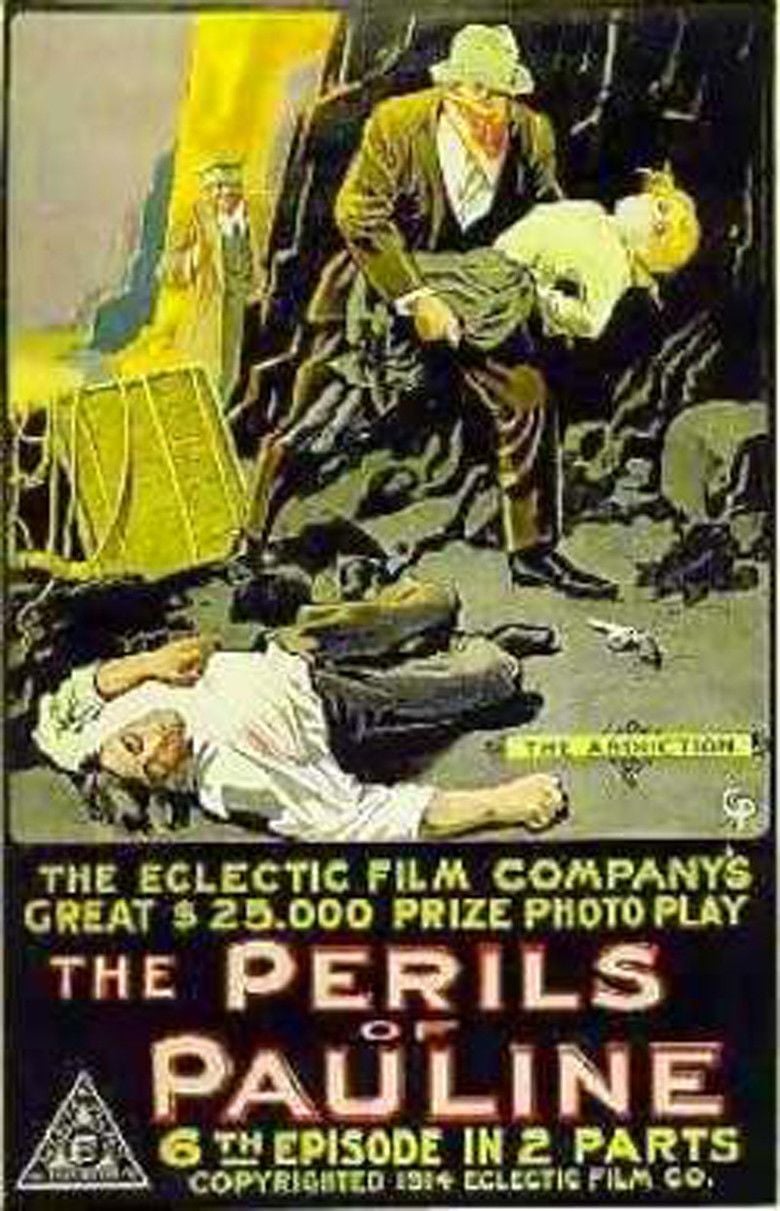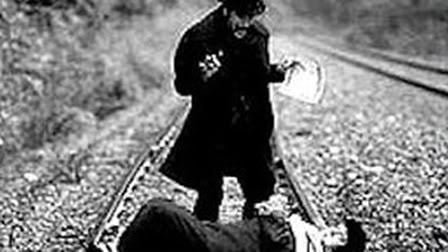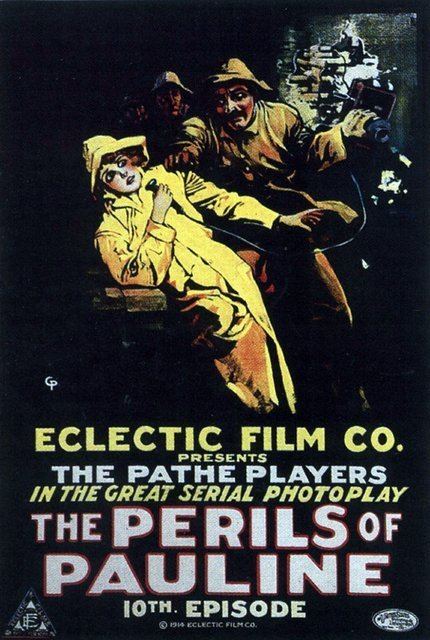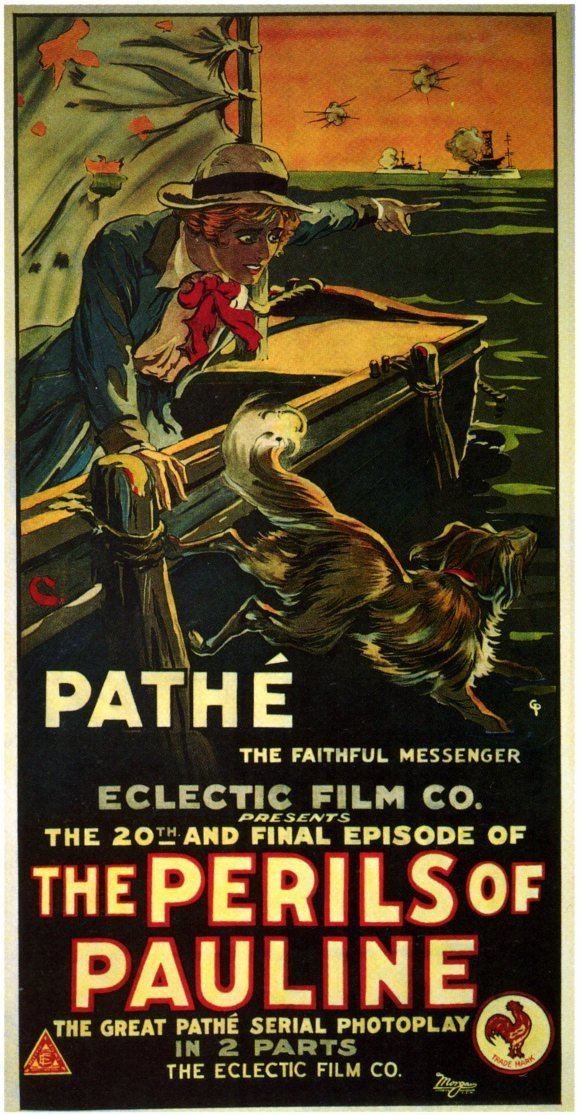The Perils of Pauline (1914 serial)
7 /10 1 Votes
6.2/10 Letterboxd Genre Action Cinematography Arthur Charles Miller Duration Country United States | 7.6/10 IMDb Director Louis J. Gasnier Costume design Lucy, Lady Duff-Gordon Language Silent | |||||||||||||||||||||||||||||||||
 | ||||||||||||||||||||||||||||||||||
Writer Charles W. Goddard , George B. Seitz Release date March 31, 1914 (1914-03-31) Cast (Child (unconfirmed)), Edward José (Sanford Marvin), (Pauline Marvin), (Harry Marvin), (Koerner / Raymond Owen)Similar movies Related Louis J Gasnier movies | ||||||||||||||||||||||||||||||||||
The perils of pauline 1914 parte 1 2
The Perils of Pauline is a 1914 American melodrama film serial shown in weekly installments, featuring Pearl White as the title character. Pauline has often been remembered as a famous example of a damsel in distress, although contemporaneous reception and some analyses hold that her character was more resourceful and less helpless than the classic damsel stereotype, and she was a considerable influence on early female audiences and attracted much critical attention therefore. Pauline is menaced by assorted villains, including pirates and Indians. Neither Pauline nor its successor, The Exploits of Elaine, used the cliffhanger format in which a serial episode ends with an unresolved danger that is addressed at the beginning of the next installment. Although each episode placed Pauline in a situation that looked sure to result in her imminent death, the end of each installment showed how she was rescued or otherwise escaped the danger. Despite popular associations, Pauline was never tied to railroad tracks in the series, an image that comes instead from contemporaneous films such as Barney Oldfield's Race for a Life.
Contents
- The perils of pauline 1914 parte 1 2
- The perils of pauline 1914 ch 1 pearl white
- Plot
- Cast
- Behind the scenes
- Sequels and remakes
- Legacy
- References

The serial had 20 episodes, the first being three reels (30 minutes), and the rest two reels (20 minutes) each. After the original run, it was reshown in theaters a number of times, sometimes in edited, shortened versions, through the 1920s. Today, The Perils of Pauline is known to exist only in a shortened 9-chapter version (approximately 214 minutes), released in Europe in 1916. '

In 2008 The Perils of Pauline was selected by the Library of Congress for preservation in the United States National Film Registry, as being "culturally, historically, or aesthetically significant."

The perils of pauline 1914 ch 1 pearl white
Plot

The premise of the story was that Pauline's wealthy guardian Mr. Marvin, upon his death, has left her inheritance in the care of his secretary, Mr. Koerner, until the time of her marriage. Pauline wants to wait a while before marrying, as her dream is to go out and have adventures to prepare herself for becoming an author. Mr. Koerner, hoping to ultimately keep the money for himself, tries to turn Pauline's various adventures against her and have her "disappear" to his own advantage.
Cast

Behind the scenes
Pearl White was hesitant to accept the title role, but signed up for $250/week and a large amount of publicity.
William Randolph Hearst was involved in plot development. He was also present at the premiere at Loew's Broadway Theatre, on 23 March 1914. According to "The Truth About Pearl White" by Wallace E. Davis, the general release was approximately 1 April 1914.
E. A. McManus, head of the Hearst-Vitagraph service organization, was the person who proved how successful a serial could be. He co-operated with the largest film equipment and production company in the world at that time, a France-based company named Pathé, to produce this serial, which was Pathé's first entry into the medium. George B. Seitz tried to follow the cliffhanging pattern of The Adventures of Kathlyn but each chapter was mostly self-contained.
After retiring from law enforcement, William J. Flynn, former director of the Bureau of Investigation (forerunner of the FBI), became a scenario writer for the motion picture industry through his acquaintance with the actor King Baggot, who was considered the greatest film star in the country at that time in 1912. Producers Theodore and Leopold Wharton commissioned him to write story lines for their films, including Pauline. The Whartons also eventually adapted Flynn's experiences into a 20-part spy thriller titled The Eagle's Eye (1918), starring Baggot.
Surviving chapters of Pauline are noteworthy for their unintentionally funny title cards and dialogue captions, filled with misspellings, poor punctuation, terrible grammar, and odd expressions. This happened when Pathé, the theatrical distributor, exported the film to France. The film was recut and adapted for home-movie use, and all of the printed captions were translated into French. Later, when the American home-movie industry beckoned, the original English titles had been scrapped, so the French technicians tried to translate the titles back into English. These errors have also been blamed on Louis J. Gasnier, director and supervisor of the production. Gasnier, as explained by Crane Wilbur, made linguistic mistakes that confused the French-speaking crew. In either case, current prints of The Perils of Pauline contain these badly re-translated title cards. Thus, in "The Pirate's Treasure", Pauline detects a time-bomb and says, "What is that tic-tac I can hear." In the same episode, she spies one of the quaint locals and observes, "Here is an original old man." The new title cards also renamed the villain's character: "Raymond Owen" was now called "Koerner," in reference to German "villainy" during World War I.
Much of the film was shot in Fort Lee, New Jersey, where many early film studios in America's first motion picture industry were based at the beginning of the 20th century. Scenes were also filmed in Pittsburgh, Pennsylvania and Staten Island, New York. The term "cliffhanger" may have originated with the series, owing to a number of episodes filmed on or around the New Jersey Palisades—though it is also likely to refer to situations in stories of this type where the hero or heroine is hanging from a cliff, seemingly with no way out, until the next episode or last-minute resolution.
Pearl White performed her own stunts for the serial. Considerable risk was involved. In one incident, a balloon carrying White escaped and carried her across the Hudson River into a storm, before landing miles away. In another incident her back was permanently injured in a fall.
Although never actually proven, one of the more famous scenes in the serial which depicted a curved railroad bridge was supposedly the Ingham Creek trestle in New Hope, Pennsylvania on the Reading Company's New Hope Branch (now the New Hope and Ivyland Railroad line). The trestle still stands, just off Ferry Street along a private driveway. Some even nickname it Pauline's Trestle. The railroad is a tourist attraction and offers rides from New Hope to Lahaska, Pennsylvania, crossing over the original trestle. Other supposed locations for the railroad scenes include the Belvidere-Delaware Railroad in Lambertville and Raven Rock, N.J. and the Long Island Rail Road in the Hamptons on Long Island.
Milton Berle (1908-2002) claimed The Perils of Pauline as his first film appearance, playing the character of a young boy, though this has never been independently verified. The serial did mark one of the early credits for the cinematographer Arthur C. Miller, who was transferred to the project from the Pathé News department.
Pathé established an American factory and studio facility in Jersey City, New Jersey in 1910, and also established the Eclectic Film Company as a subsidiary distribution company for both its American and European products. Although the Jersey City plant produced moderately popular comedies, dramas, and newsreels largely directed at the US market, Pauline was the first American-made Pathé effort to achieve worldwide success under the Eclectic banner.
The final peril has Pauline sitting in a target boat as the Navy opens fire. The idea was also used in To the Shores of Tripoli (1942, Fox).
Sequels and remakes
This successful serial was quickly followed by The Exploits of Elaine, also starring White. Many imitations and parodies followed, heralding the first golden age of the American film serial.
The title The Perils of Pauline was reused by Universal Studios for a 1933 sound serial with a different plot, by Paramount Pictures as the Betty Hutton vehicle The Perils of Pauline (1947), and by Universal again in 1967 as an updated comedy.
An abortive mixed-media musical was planned to be based on the film, called Who's That Girl?, meant to be premiered by The Boys from Syracuse producer Richard York on Broadway in 1970, with a book written by Lewis Banchi and Milburn Smith, and with the planned participation of the songwriting duo Ray Evans and Jay Livingston.
Legacy
The Perils of Pauline is the prime example of what author Ben Singer has called the "serial-queen melodrama." It is remembered as a paradigmatic form of damsel in distress cinema, as well as for its extensive use of the cliffhanger technique in film serials.
There has been a recent reassessment of Singer's model in the light of broader film forms.
The film's style was later subject to nostalgic caricature in many forms (e.g. Dudley Do-Right), but the original heroine was neither as helpless as the caricatures, nor did the original film include the much-parodied "tied to railroad tracks" or "tied to buzzsaw" scenarios which appeared in later films in this vein. Even the title phrase "Perils of" was often adopted by later serials, for example, in Universal's Perils of the Secret Service, Perils of the Wild, and Perils of the Yukon.
The 1969–70 cartoon series The Perils of Penelope Pitstop was patterned after this serial, and included the plot point of the villain trying to eliminate the heroine so he can keep her inheritance.
The Thunderbirds episode "Perils of Penelope" was inspired by The Perils of Pauline.
References
The Perils of Pauline (1914 serial) WikipediaThe Perils of Pauline (1914 serial) IMDbThe Perils of Pauline (1914 serial) LetterboxdThe Perils of Pauline (1914 serial) themoviedb.org
